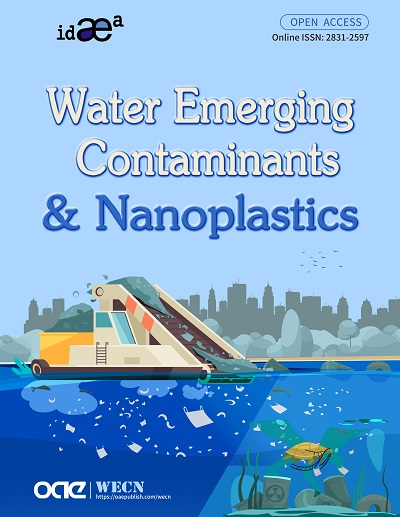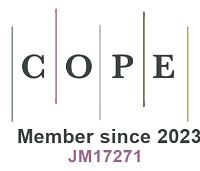How microplastics and nanoplastics shape antibiotic resistance?
Despite the remarkable benefits and convenience of plastics to human lives, there is increasing awareness about the negative environmental impacts arising from the vast amount of plastic waste. Due to the environmental weathering over time, fragmentation of plastics can happen, leading to microplastic (< 5 mm) and nanoplastic (< 100 nm) generation. As a hot environmental topic in the past decade, more and more studies have focused on the subjects of microplastic and nanoplastic pollution, i.e., qualitative and quantitative methods, environmental fate and behavior, biological consequences, and potential removal techniques[1-5]. In addition, concerns about the relationship between antibiotic resistance and micro/nanoplastics have arisen with the recent one-health concept[6].
Antibiotic resistance is one of the biggest threats to global health, as the proliferation of resistance reduces or eliminates the utility of antibiotics, rendering some clinical infections dangerously untreatable. Therefore, gaining insight into mechanisms driving the dissemination and propagation of antibiotic resistance genes (ARGs) is essential. The use of antibiotics is usually considered to be the main driving factor for the development and selection of ARGs[7]. Additionally, due to the co-selection mechanisms, anthropogenic levels of toxic heavy metals have also been associated with the dissemination of ARGs[8]. Recent evidence that microorganisms colonizing microplastics are resistant to antibiotics and that microplastics increase the gene exchange in aquatic ecosystems suggests that microplastics could have ramifications on disease transmission and treatment [Table 1]. To further illustrate the relationship between micro/nanoplastics and ARGs, we used the Web of Knowledge database to retrieve publications. The results were further viewed by CiteSpace[9]. The high-frequency keywords included microbial community disturbance, conjugative antibiotic resistant plasmid, occurrence removal, microplastic biofilm, and potential carrier [Figure 1], suggesting that researchers dominantly focused on the correlation between ARGs and microbial communities on plastics, the plastic-induced gene transfer, and vector roles of plastics.
The studies related to micro/nano-plastics and ARGs
| MP type | Design | Methods | Main results | Reference |
| Plastic particles | Filed-collected samples | Metagenomics | • Higher levels of ARGs were observed on plastics, and a correlation between ARGs and bacterial communities was observed | [10] |
| HDPE | In situ incubation | HT-qPCR | • A total of 82 ARGs, 12 MGEs, and 63 bacterial pathogens were detected in the plastisphere, and the correlation between ARGs and bacterial communities was observed | [21] |
| PE, PP | Ex situ microcosm with landfill leachate | qPCR | • MPs exhibited selective enrichment for ARGs in a ratio of 5.7-103 folds • Closer and more stable ARGs-bacterial taxa relations on MP surface affected the ARG transmission | [22] |
| PS, PP, PE, PET, PVC | Field-collected samples | qPCR | • ARG absolute abundance showed: biofilms on plastics > sediment > water • Firmicutes showed significant correlations with sul1 and tetA on PE | [23] |
| PE, PP | Field-collected samples | qPCR | • MPs selectively enriched antibiotic resistant genes with distinct ARG profiles, and a correlation between ARG profile and bacterial composition was obtained | [13] |
| PE | Ex situ microcosm with water samples | qPCR | • MPs can enrich antibiotics, ARGs and microbes from the surrounding water | [12] |
| PVC | Sewage microcosm | HT-qPCR | • PVC MPs could enrich bacteria and resistance genes from surrounding sewage | [24] |
| PE, PVC | Sewage microcosm | HT-qPCR | • MPs led to the increase of the total copies of ARGs and mobile genetic elements (MGEs) in the sewage • Multidrug ARGs and MGEs were enriched on plastisphere | [25] |
| PHA, PET | In situ incubation | Metagenomics | • Plastic type significantly influenced the ARG composition in the biofilms, and the abundance of multidrug resistance genes on PET was relatively higher • A good-fit correlation between ARG profile and bacterial composition was obtained | [11] |
| Aged PS MPs | Incubation with goldfish | Metagenomic | • Microplastics promote the occurrence of ARGs in the intestine | [26] |
| PE, PP, PS, recycled PE | Ex situ microcosm with wastewater | qPCR | • PP have the highest adsorption capacity of ARGs among all microplastics • Exposure to microplastics enhances horizontal gene transfer of ARGs | [15] |
| PS N/MPs | Ex situ microcosm with landfill leachate | qPCR | • ARGs were enriched more in the 200–500 nm MP group • The potential ARG-carrying bacteria increased in the N/MP exposed groups | [19] |
| PS N/MPS | Incubation with earthworms | Metagenomics | • Microplastics (MPs) impact the occurrence of ARGs in earthworm guts | [27] |
| PA, PET, PLA | Indoor collected MPs | qPCR | • Relative abundance of ARGs on MPs was higher, and a correlation between ARGs and bacterial communities was observed | [16] |
| PS NPs | Incubation with Enchytraeus crypticus | HT-PCR | • NPs enhanced the toxicity of tetracycline and promoted ARGs enrichment • NPs + TC caused more serious ARGs enrichment in E. crypticus than in soils | [28] |
| PS N/MPs | E. coli incubation | • PS particles with sizes ≤ 100 nm impacted the transformation of ARGs • PS particles interfered with plasmid replication inside E. coli, thus decreasing the bacterial transformation and affecting the dissemination of ARGs | [20] | |
| PE | Ex situ incubation | qPCR | • PE MPs significantly increased the fold changes in the abundances of tetC, tetG, and tetW • Free ammonia contributed the most to the changes in host bacteria, which probably changed the fate of ARGs | [29] |
| PVC | In situ incubation | qPCR | • PVC MPs benefited the propagation of intI1 and tetE in the AGS system • PVC MPs positively correlated with some Accumulibacter clades and ARGs | [30] |
| PS NPs | In situ incubation | qPCR | • The thermal hydrolysis process reduced ARG propagation that can be encouraged by PS NPs | [31] |
| PET | Incubation with mice | HT-qPCR | • MPs could exacerbate the effects of SMX on gut microbiota and ARG profile • SMX and MPs exposure significantly increased the relative abundances of ARGs | [32] |
| PE, PP, PS, PET, PCL | In situ incubation | qPCR | • Sociometric and environmental factors were the main drivers shaping the distribution characteristics of ARGs and MGEs • PP and HDPE particles are preferred substrates for obtaining diffuse ARGs | [33] |
Microplastics could selectively enrich ARGs. By analyzing the metagenomic data of plastic particles from the North Pacific Gyre, Yang et al. (2019) first reported that the abundance of total ARGs on microplastics was significantly greater than that in seawater[10]. Since this study, understanding the roles of microplastics in carrying ARGs has become an important area to explore. The ARGs on the microplastics collected from the oceans[11], estuaries[12], urban rivers[13], farmlands[14], wastewater treatment plants[15], and even indoor air[16] have been estimated. Most studies illustrated that the ARG abundance and diversity were significantly different from those in the surrounding environments, which was closely associated with distinct microbial communities on the microplastics. Additionally, the bacterial communities on microplastics may be denser, further enhancing the horizontal gene transfer rate of ARGs on microplastics. Several studies have measured the indicator gene of horizontal gene transfer on microplastics and proved this hypothesis[13].
Microplastics may also affect the ARGs in surrounding environments. For instance, Song et al. (2022) reported that biodegradable microplastics significantly changed the ARG compositions and broadened their bacterial hosts, which was due to the fact that generated water-soluble low molecular weight oligomers from the biodegradable microplastics may act as additional carbon sources for microbial assimilation[17]. Lu and Chen (2022) also found that the ARG characteristics in soils were changed after microplastic amendment, which was attributed to the sorbed phthalates[18]. Unfortunately, not enough studies have evaluated this question. Based on their natural properties, e.g., undissolved solid particles, it is not easy for microplastics to enter into bacteria and induce the expression of ARGs. Thus, the co-selection mechanisms may not be appropriate for microplastic exposure. They may not directly target the ARGs but indirectly through changing the communities of ARG bacterial hosts or leaching chemicals to show selective pressures.
Although microplastics and nanoplastics share similar composition and origin, the nanospecific properties (e.g., transport properties, bioavailability, interactions with natural colloids, and potential toxicity) distinguish nanoplastics from microplastics. Therefore, nanoplastics may affect the dissemination of ARGs via different mechanisms. Shi et al. (2020) found that the ARGs in municipal landfill leachate were enriched in the nanoplastic exposed group. They reported that nanoplastics could induce the production of reactive oxygen species (ROS), which potentially increase bacterial membrane permeability and thus facilitate the intra-bacterial community transfer of mobile genetic elements[19]. Similarly, Hu et al. (2022) observed that nanoplastics can promote the transformation of ARGs, and the enhancing mechanism was the direct interaction of nanoplastics with membrane lipids and the indirect effect associated with bacterial oxidative stress response[20]. Both processes can induce the formation of pores on the cell membrane and increase the membrane permeability, thus enhancing gene transformation.
Despite the growing literature on the effects of micro/nanoplastics on ARGs, most studies only observed the correlation between microbial communities and ARG profiles, which is not the underlying reason plastics could selectively recruit ARGs. For microplastics, we may hypothesize that the microplastics can selectively recruit microorganisms growing on microplastics, which contributes to the distinct ARG profiles on microplastics. The closer physical distance of microorganisms would induce the horizontal gene transfer. Thus, further studies should focus on why the microplastics have the ability to show selective recruitment and whether the levels of gene exchanges on microplastics are higher. For nanoplastics, their attack on the cell wall may be more important for gene exchanges. More attention should focus on how micro/nanoplastics mediate the ARG transformation.
DECLARATIONS
Authors’ contributionsMade a substantial contribution to data curation, methodology, writing - original draft: Sun Y
Made a substantial contribution to methodology, writing - reviewing and editing, supervision: Wang J
Availability of data and materialsNot applicable.
Financial support and sponsorshipNone.
Conflicts of interestBoth authors declared that there are no conflicts of interest.
Ethical approval and consent to participateNot applicable.
Consent for publicationNot applicable.
Copyright© The Author(s) 2022.
REFERENCES
1. Galloway TS, Cole M, Lewis C. Interactions of microplastic debris throughout the marine ecosystem. Nat Ecol Evol 2017;1:116.
2. Mitrano DM, Wohlleben W. Microplastic regulation should be more precise to incentivize both innovation and environmental safety. Nat Commun 2020;11:5324.
3. Isobe A, Iwasaki S, Uchida K, Tokai T. Abundance of non-conservative microplastics in the upper ocean from 1957 to 2066. Nat Commun 2019;10:417.
6. Bank MS, Ok YS, Swarzenski PW. Microplastic’s role in antibiotic resistance. Science 2020;369:1315.
7. Blair JM, Webber MA, Baylay AJ, Ogbolu DO, Piddock LJ. Molecular mechanisms of antibiotic resistance. Nat Rev Microbiol 2015;13:42-51.
8. Li LG, Xia Y, Zhang T. Co-occurrence of antibiotic and metal resistance genes revealed in complete genome collection. ISME J 2017;11:651-62.
9. Chen C. CiteSpace II: Detecting and visualizing emerging trends and transient patterns in scientific literature. J Am Soc Inf Sci 2006;57:359-77.
10. Yang Y, Liu G, Song W, et al. Plastics in the marine environment are reservoirs for antibiotic and metal resistance genes. Environ Int 2019;123:79-86.
11. Sun Y, Cao N, Duan C, Wang Q, Ding C, Wang J. Selection of antibiotic resistance genes on biodegradable and non-biodegradable microplastics. J Hazard Mater 2021;409:124979.
12. Wang S, Xue N, Li W, Zhang D, Pan X, Luo Y. Selectively enrichment of antibiotics and ARGs by microplastics in river, estuary and marine waters. Sci Total Environ 2020;708:134594.
13. Wang J, Qin X, Guo J, et al. Evidence of selective enrichment of bacterial assemblages and antibiotic resistant genes by microplastics in urban rivers. Water Res 2020;183:116113.
14. Ding J, Zhu D, Wang Y, et al. Exposure to heavy metal and antibiotic enriches antibiotic resistant genes on the tire particles in soil. Sci Total Environ 2021;792:148417.
15. Cheng Y, Lu J, Fu S, Wang S, Senehi N, Yuan Q. Enhanced propagation of intracellular and extracellular antibiotic resistance genes in municipal wastewater by microplastics. Environ Pollut 2022;292:118284.
16. Peng C, Zhang X, Zhang X, et al. Bacterial community under the influence of microplastics in indoor environment and the health hazards associated with antibiotic resistance genes. Environ Sci Technol 2022;56:422-32.
17. Song R, Sun Y, Li X, et al. Biodegradable microplastics induced the dissemination of antibiotic resistance genes and virulence factors in soil: a metagenomic perspective. Sci Total Environ 2022;828:154596.
18. Lu XM, Chen YL. Varying characteristics and driving mechanisms of antibiotic resistance genes in farmland soil amended with high-density polyethylene microplastics. J Hazard Mater 2022;428:128196.
19. Shi J, Wu D, Su Y, Xie B. (Nano)microplastics promote the propagation of antibiotic resistance genes in landfill leachate. Environ Sci: Nano 2020;7:3536-46.
20. Hu X, Waigi MG, Yang B, Gao Y. Impact of plastic particles on the horizontal transfer of antibiotic resistance genes to bacterium: dependent on particle sizes and antibiotic resistance gene vector replication capacities. Environ Sci Technol 2022;forthcoming.
21. Yang K, Chen QL, Chen ML, et al. Temporal dynamics of antibiotic resistome in the plastisphere during microbial colonization. Environ Sci Technol 2020;54:11322-32.
22. Su Y, Zhang Z, Zhu J, et al. Microplastics act as vectors for antibiotic resistance genes in landfill leachate: The enhanced roles of the long-term aging process. Environ Pollut 2021;270:116278.
23. Guo XP, Sun XL, Chen YR, Hou L, Liu M, Yang Y. Antibiotic resistance genes in biofilms on plastic wastes in an estuarine environment. Sci Total Environ 2020;745:140916.
24. Zhao Y, Gao J, Wang Z, Dai H, Wang Y. Responses of bacterial communities and resistance genes on microplastics to antibiotics and heavy metals in sewage environment. J Hazard Mater 2021;402:123550.
25. Wang Z, Gao J, Zhao Y, Dai H, Jia J, Zhang D. Plastisphere enrich antibiotic resistance genes and potential pathogenic bacteria in sewage with pharmaceuticals. Sci Total Environ 2021;768:144663.
26. Zhang P, Lu G, Sun Y, Yan Z, Dang T, Liu J. Metagenomic analysis explores the interaction of aged microplastics and roxithromycin on gut microbiota and antibiotic resistance genes of Carassius auratus. J Hazard Mater 2022;425:127773.
27. Xu G, Yu Y. Polystyrene microplastics impact the occurrence of antibiotic resistance genes in earthworms by size-dependent toxic effects. J Hazard Mater 2021;416:125847.
28. Yang L, Wang X, Ma J, Li G, Wei L, Sheng GD. Nanoscale polystyrene intensified the microbiome perturbation and antibiotic resistance genes enrichment in soil and Enchytraeus crypticus caused by tetracycline. Applied Soil Ecology 2022;174:104426.
29. Zhang Q, Fan D, Pang X, Zhu W, Zhao J, Xu J. Effects of polyethylene microplastics on the fate of antibiotic resistance genes and microbial communities in anaerobic digestion of dairy wastes. J Clean Prod 2021;292:125909.
30. Dai H, Gao J, Wang Z, Zhao Y, Zhang D. Behavior of nitrogen, phosphorus and antibiotic resistance genes under polyvinyl chloride microplastics pressures in an aerobic granular sludge system. J Clean Prod 2020;256:120402.
31. Azizi SMM, Haffiez N, Zakaria BS, Dhar BR. Thermal hydrolysis of sludge counteracts polystyrene nanoplastics-induced stress during anaerobic digestion. ACS EST Eng 2022;forthcoming.
32. Liu J, Lv M, Sun A, et al. Exposure to microplastics reduces the bioaccumulation of sulfamethoxazole but enhances its effects on gut microbiota and the antibiotic resistome of mice. Chemosphere 2022;294:133810.
Cite This Article
How to Cite
Sun, Y.; Wang J. How microplastics and nanoplastics shape antibiotic resistance?. Water Emerg. Contam. Nanoplastics. 2022, 1, 8. http://dx.doi.org/10.20517/wecn.2022.09
Download Citation
Export Citation File:
Type of Import
Tips on Downloading Citation
Citation Manager File Format
Type of Import
Direct Import: When the Direct Import option is selected (the default state), a dialogue box will give you the option to Save or Open the downloaded citation data. Choosing Open will either launch your citation manager or give you a choice of applications with which to use the metadata. The Save option saves the file locally for later use.
Indirect Import: When the Indirect Import option is selected, the metadata is displayed and may be copied and pasted as needed.
















Comments
Comments must be written in English. Spam, offensive content, impersonation, and private information will not be permitted. If any comment is reported and identified as inappropriate content by OAE staff, the comment will be removed without notice. If you have any queries or need any help, please contact us at support@oaepublish.com.